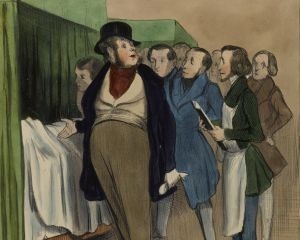
 Honoré Daumier, Clinique du docteur Macaire, estampe de 1836, Maison de Balzac.
Honoré Daumier, Clinique du docteur Macaire, estampe de 1836, Maison de Balzac.
The bed is certainly the object of the daily life to which one thinks most easily at the mention of the history of the hospital. This removable piece of furniture, which is nowadays designed to ensure the convalescence and guarantee the comfort of a patient, was nevertheless established in the French and European hospitals only during the 19th century, a period during which it gradually replaced the old benches and collective beds that characterized the hospices at the time. It is also around these beds that the management of patients was formalized and that the hospital space was organized. The place and function of the bed in hospitals has therefore been a health issue for public authorities, as well as a subject regularly addressed by doctors in the medical literature. Also, it is hardly surprising to note that the very term “bed” has covered several meanings.
Since the end of the 18th century, medical textbooks have defined the bed as an instrument of clinical medicine. This new medicine, which involved the active participation of the doctor to observe the signs of the disease, was practised at the bedside of the patient. The doctor interviewed the patient, analyzed his condition, observed the signs and identified the symptoms that characterized the disease. In addition, it was around the beds that a set of medical practices and rituals were developed, punctuating the daily life of hospitals. It is during the medical examinations, during which the head of the department, accompanied by his interns, observed the good performance of the service, that the patients were examined bedridden. This daily ritual allowed the doctor to give his clinical teaching by taking as examples the most significant cases. In this sense, the bed remained during the 19th century a medium of observation and teaching, whose diffusion allowed the development of hospital medicine. The clinical examination was nevertheless carried out in plain sight, without regard for intimacy. Even though during the 19th century the bed became, very gradually, a piece of furniture specifically reserved for an individual, it was not yet an individualized space.
An instrument of care and clinical teaching, although, the bed also appears through the hospital documents as an object that doctors and caregivers have gradually appropriated to objectify their medical discourse. The reading of the various regulations of the hospitals of the 19th and 20th centuries attests to the great diversity of the models of beds proposed. Removable beds with casters or fixed on the floor, iron beds with a box spring or zinc beds formed by four inclined planes with an opening, all these models complied with the therapeutic and organizational imperatives of the medical specialties. The beds in psychiatric institutions were distinguished from those in regular hospitals by their rounded edges and lack of bars. Characteristics that reflect the willingness of psychiatrists to prevent injuries and suicide attempts. The bed in psychiatric hospitals was, in this way, as much an instrument of behavioural control as a therapeutic tool.
From the last third of the 19th century until the 1980s, the bed was mainly mentioned in the press through the problem of clutter. The lack of beds in hospitals was denounced by both doctors and public authorities as an obstacle to medicalization. In psychiatry, hospital overcrowding was so severe that many head doctors were forced to save space and even had to house their patients with mattresses directly on the floor. In order to remedy this situation, the various modernization and equipment plans implemented in the second part of the 20th century foresaw the construction of tens of thousands of beds. These programs defined the hospital bed as a unit of measure for both determining the hospital’s hospitalization capacity and assessing the needs of the population. This policy was called into question at the end of the 1970s, because of the economic crises and a general reorientation of hospital policy favouring the construction of individualized rooms and the development of new methods of taking charge.
These different definitions show that the bed was not reduced to a simple object whose arrangement punctuated the spatial organization of the services. It was not only a therapeutic instrument around which various medical practices had been formalized, but also an indicator allowing public authorities to guide hospital policy.
Read more in the dictionary : D’Arsonval chronometer - The suitcases of Willard State Hospital
Read the paper in French : Lit
Références :
Claire Barillé, « Les vaines pudeurs à l'hôpital (XIXe siècle) », Histoire, médecine et santé, 2012/1 (n°1), p. 47-61.
Benoît Majerus, « La baignoire, le lit et la porte. La vie sociale des objets de la psychiatrie », Genèses, 2011/1 (n° 82), p. 95-119.
To quote this paper : Gaspard Bouhallier, “Bed”, in Hervé Guillemain (ed.), DicoPolHiS, Le Mans Université, 2022.